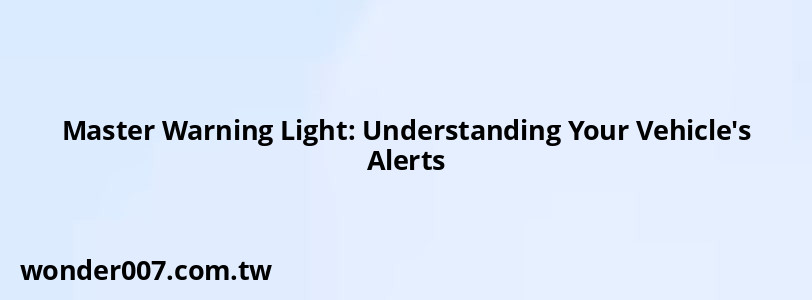Master Warning Light: Understanding Your Vehicle's Alerts

The master warning light is a critical indicator on your vehicle's dashboard that signals potential issues requiring immediate attention. Understanding what this light means and how to respond can help ensure your safety and the longevity of your vehicle.
What is the Master Warning Light?
The master warning light typically appears as an amber or red icon, often featuring an exclamation point inside a triangle. This light serves as a general alarm for various issues within your vehicle's systems. When illuminated, it indicates that the internal diagnostic computer has detected a problem that could range from minor to severe.
Common Causes of the Master Warning Light Activation
- Engine Problems: Issues related to engine performance, such as overheating or failure, can trigger this alert.
- Fluid Levels: Low or high levels of essential fluids like oil, coolant, or brake fluid may activate the light.
- Battery Concerns: Problems with the battery or charging system can also cause the master warning light to illuminate.
- Safety System Alerts: Warnings related to airbags or other critical safety mechanisms are often indicated by this light.
Immediate Actions Required
When the master warning light activates, it's essential to take it seriously:
- Check Other Warning Lights: Often, this light will accompany other specific warnings that provide more detail about the issue at hand.
- Consult Your Owner's Manual: The manual can offer insights into what the specific warning means for your vehicle model.
- Seek Professional Help: If you're unsure about the cause of the warning, it's best to consult a qualified mechanic to prevent potential damage.
Driving with the Master Warning Light On
While some situations may allow you to continue driving—like a loose gas cap or minor sensor malfunction—caution is paramount. If you suspect a serious issue, such as engine overheating or brake failure, pull over safely and seek assistance immediately. Ignoring these warnings could lead to catastrophic failures and costly repairs.
FAQs About Master Warning Light
- What does it mean if my master warning light is on?
This indicates that there is a significant issue within your vehicle's systems that requires immediate attention. - Can I drive with the master warning light on?
It depends on the situation; if it’s accompanied by other serious warnings, it’s best to stop and seek help. - What should I do if the master warning light comes on?
Check for other warning lights, consult your owner’s manual, and consider taking your vehicle to a mechanic.
Understanding the master warning light is crucial for every driver. By recognizing its significance and responding appropriately, you can maintain your vehicle's health and ensure your safety on the road.
Related Posts
-
Pilot Bearing vs Throwout Bearing: Understanding Noise Differences
30-01-2025 • 147 views -
Stop Start Warning Light: What It Means and How to Fix
26-01-2025 • 147 views -
Service Stab System: Understanding Vehicle Stability
28-01-2025 • 137 views -
EPC Light: Understanding Causes and Solutions
26-01-2025 • 1019 views -
Steering Wheel Exclamation Mark: Troubleshooting Your Car Won't Start Issue
26-01-2025 • 227 views
Latest Posts
-
2015 Chevy Traverse AC Recharge Port Location
01-02-2025 • 365 views -
Are O2 Sensors Covered Under Warranty
01-02-2025 • 338 views -
Rear Brake Caliper Piston Won't Compress
01-02-2025 • 312 views -
Power Steering Fluid Leak On Passenger Side
01-02-2025 • 419 views -
How To Turn Off Paddle Shifters Mercedes
01-02-2025 • 333 views
Popular Posts
-
Power Steering and ABS Light On: Causes and Solutions
27-01-2025 • 612 views -
Hino Warning Lights: Understanding Dashboard Alerts
26-01-2025 • 634 views -
V12 Engine Costs: What You Need to Know
26-01-2025 • 630 views -
EPC Warning Light: What It Means for Your Vehicle
27-01-2025 • 591 views -
EPC Light: Understanding Causes and Solutions
26-01-2025 • 1019 views
